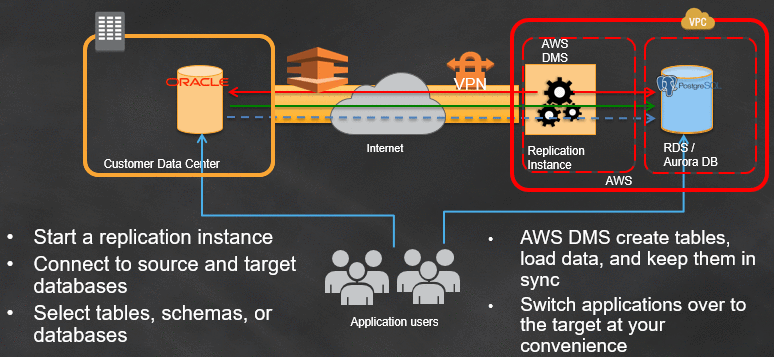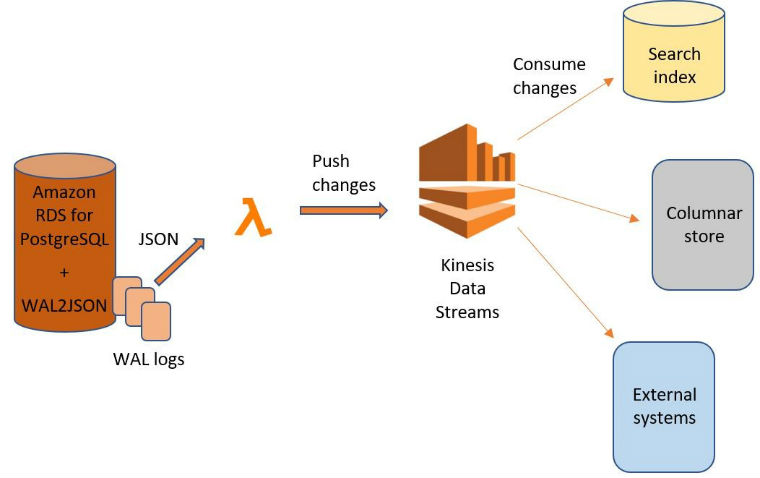AWS Database Blog
Tag: Amazon RDS
Recap of Amazon RDS features launched in 2018
Amazon Relational Database Service (Amazon RDS) makes it easy to set up, operate, and scale a relational database in the cloud. It provides cost-efficient and resizable capacity. At the same time, it automates time-consuming administration tasks such as hardware provisioning, database setup, patching, and backups. It frees you to focus on your applications so you […]
Best practices for migrating an Oracle database to Amazon RDS PostgreSQL or Amazon Aurora PostgreSQL: Source database considerations for the Oracle and AWS DMS CDC environment
An Oracle to PostgreSQL migration in AWS Cloud can be a complex multistage process with different technologies and skills involved, starting from the assessment stage to the cutover stage. To better understand details of the complexities involved, see the AWS Database Blog post Database Migration—What Do You Need to Know Before You Start? This blog […]
How to use CloudWatch metrics to decide between General Purpose or Provisioned IOPS for your RDS database
July 2023: This post was reviewed for accuracy. In this blog post, I talk about how you can use Amazon CloudWatch metrics to understand when you might benefit from provisioned IOPS, also known as IO1 volumes, for highest performance mission-critical database workloads. I start by setting up a test case that simulates a nonbursting consistent […]
Powering up Database Mail on Amazon RDS for SQL Server – How Under Armour runs Database Mail on Amazon RDS for SQL Server
Update [11/04/2020]: We’re happy to announce that Amazon RDS for SQL Server now fully supports SQL Server Database Mail. With the release of Database Mail for SQL Server, you can enable Database Mail seamlessly by using database parameter groups. Check this blog post for more information. Database Mail is one of the heavily […]
RDS SQL Server has two new exciting backup and restore enhancements
Amazon Relational Database Service (Amazon RDS) is the primary mechanism for running relational databases in the AWS Cloud. Amazon RDS for SQL Server supports running SQL Server versions from SQL Server 2008 R2 to SQL Server 2017. The RDS for SQL Server team has recently released two key improvements around backup and restore for native […]
Supercharge your Amazon RDS for MySQL deployment with ProxySQL and Percona Monitoring and Management
So your organization is looking to deploy an application to the cloud, and you plan to use Amazon RDS for MySQL for the data tier… great! Let’s look at some of the best practices to ensure that you get the most out of your architecture.
Best practices for upgrading SQL Server 2008 R2 to SQL Server 2016 on Amazon RDS for SQL Server
In preparation for the deprecation of Microsoft SQL Server 2008 R2, this blog post focuses on how to upgrade from SQL Server 2008 R2 to SQL Server 2016 on Amazon RDS for SQL Server. In addition, you can apply many of the practices in this post to all versions of SQL Server or even other […]
Recover from a disaster with delayed replication in Amazon RDS for MySQL
July 2023: This post was reviewed for accuracy. Amazon RDS for MySQL now supports a delayed replication, which allows you to set a time period that a replica database lags behind a source database. In a standard MySQL replication configuration, there is minimal delay between the source and the replica. Now you have the option […]
How to migrate an application from an on-premises Oracle database to Amazon RDS for PostgreSQL
For years, companies have had to set up their own local databases and maintain the hardware themselves. However, as the cloud infrastructure continues to improve, there’s far less need to own and manage your own hardware. Here at Amazon, we own hundreds (if not thousands) of on-premises databases that over time we have migrated to […]
Stream changes from Amazon RDS for PostgreSQL using Amazon Kinesis Data Streams and AWS Lambda
In this post, I discuss how to integrate a central Amazon Relational Database Service (Amazon RDS) for PostgreSQL database with other systems by streaming its modifications into Amazon Kinesis Data Streams. An earlier post, Streaming Changes in a Database with Amazon Kinesis, described how to integrate a central RDS for MySQL database with other systems […]








